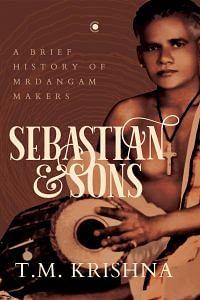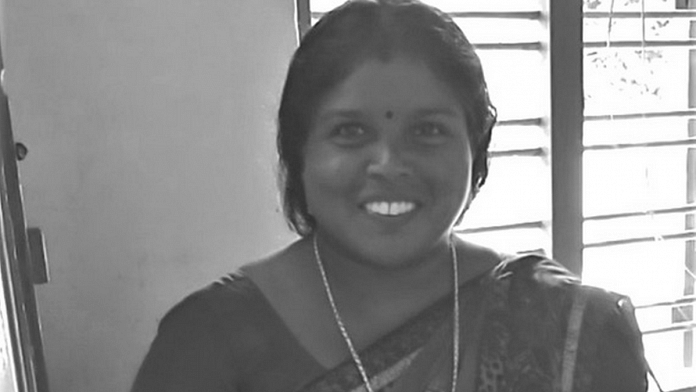Even today, women fight to establish their rightful place as mrdangam artists in what is accepted as a man’s world.
Mrdangam-making too has always been a male-controlled territory. Women have always provided assistance in this home-based industry, but they are rarely spoken of. They do the physically taxing ‘crushing the stone’ job and help with drying skin, but there is a generally accepted notion that mrdangam making is too difficult for womankind, especially the skin-related stuff. But amongst them there have been those few who have ignored the boundaries laid out by men to earn their living.
The Skin Expert
Kasumani had informed me that it was his daughter-in-law who nails and dries the fresh cow and buffalo skin, but somehow it had not registered.
Turns out, she is not exactly Kasumani’s daughter-in-law. Her name is A. Geetha, and her brother Manikandan is married to Kasumani’s daughter. But, as is common among insular Indian families, there is another connection. Geetha’s paternal grandmother, Ponni, is Kasumani’s paternal aunt.
I had observed that the women in almost all mrdangam-making families contributed to the work, but this was usually limited to powdering the stone or applying the sadam. This was the first time I was meeting a woman in a maker’s family who took care of the skin processing entirely on her own.
Also read: TM Krishna’s book celebrating Dalit Christian mrdangam makers triggers row in Tamil Nadu
Geetha’s father was a well-known Coimbatore-based mrdangam maker, and she grew up watching him work. ‘My father, Appu, used to work out of our home. He could even play the mrdangam. When I was a child, I used to help him, and so, I never had any feeling of disgust looking at skin. One day, a person brought a skin, and there was nobody to nail it because my father was ill. Due to high blood pressure, he was half-paralysed. Skin cannot lie around for a long time; it has to be cleaned and nailed as soon as possible, otherwise it starts smelling. But my brother, who was in his teens then, was scheduled to return only at 3 p.m. So my father told me that he would give me instructions and I should just follow. I agreed, and learnt the job.’
Geetha moved to Peruvemba after her marriage, but life was not easy. They were struggling to make ends meet. She wanted to find a way to contribute to the family income. With two little children at home, going outside to work was out of the question. Her husband Shankaranarayanan was already working with skin processing. She began helping him out. Today, she has taken over completely, and it has become her profession. ‘I may well be the one lady who is doing this skin-beating job,’ she said with a beaming smile. Rather than being disapproving, her husband’s family are proud of her.
The skins are chosen and supplied by Kaja Hussain from Pudunagaram, near Palakkad. But Geetha advises him on how to choose. ‘I tell him: that is thick, this skin is thinner, this has got knife marks, that has a hole …’ She then went on to describe their process for preparing the skin. ‘We nail it and remove the flesh and fat. If it is not removed, the varu will tear. We then leave it under the sun for two days and nights. Sometimes, if it is really hot, the skin might even dry by the end of the day. So we remove the whole skin and hang it on a bamboo pole. The next day, we dry the other side (the hairy side) for a couple of hours. If the skin does not dry properly, it may curl in different places, and then my customers will not be able to remove the hair. At times, I work from 9 a.m. to 1 p.m. without a break.’ Geetha buys cow and buffalo skin from Kaja Hussain for about Rs 1,500. The price varies, depending on the size. She adds to it her ‘kooli’ (wages), which works to about Rs 400, marks up the price accordingly and sells it. Her selling price is anywhere between Rs 2,000 and 2,500 (price varies depending on the size of the skin). Geetha’s customers primarily make mrdangams and chenda, and they come from all over the region, including Thalasseri, Thrissur, Trivandrum, Ernakulam and Coimbatore.
Also read: Opposition to TM Krishna’s concerts is unacceptable intolerance
‘In a week, we may sell ten to fourteen skins. We have the facility to nail four skins in our home. So, we dry the skin and store it. Some people come and buy in bulk. We have to sell minimum two a day to meet our kooli. If we sell more, it is profit,’ Kasumani’s son Rajesh added.
For the chenda, she prepares bull skin and says that, if it is thin enough, which is rare, it could work for the mrdangam too, replacing cow skin on the valandalai. ‘You will get good nadam,’ she claimed. She even sends bull skin for the Nashik dhol. According to Geetha, bull skin has veins but cow skin does not. This gives bull skin the tone needed for the chenda and the dhol. Geetha reserves goat-skin supply exclusively for her brother Manikandan, who runs Appu Mridangam Tabala Works in Coimbatore. The affection in her tone when she mentioned her brother spoke volumes.
When it rains—and it does pour down in this part of the country, especially in June and July—work becomes an ordeal. ‘We use tarpaulin during the rainy season to keep the skin dry.’ They cover the stretched and nailed skin with a tent-like structure, but if the rains are too heavy, even that does not hold. Work comes to a standstill. On normal days, they roll and store the dried skin for up to a month because customers buy only when there is a requirement. But during the rains, fungi could destroy it.
Also read: TM Krishna promises 1 Allah, Jesus song a month after Hindu group attacks Carnatic singers
Geetha’s seventeen-year-old son has watched his mother pull, nail, clean and dry these skins day in and day out for years. ‘It is under the hot sun, very tedious and a hard job. But I am used to the smell now. When the skin is fresh, it does not smell, but after some time, around mid-day, it will start smelling. My mother continued working even when she was pregnant with me. If she asks me to do it, I will,’ he said. Initially, when Geetha began working, she would do everything behind the house, so that people did not see her. Not anymore. In fact, her brother-in-law and his wife have followed in her footsteps, doing the skin-processing in their yard, just next door.
‘My family is surviving because of what my father taught me. I am educating my children with the profits from this job. My father always told me that, “You are not a girl child, you are my older son,”’ Geetha said, voice cracking. ‘I feel so emotional whenever I speak about him. He is no more, but all the credit goes to him.’
 Excerpted with permission from Sebastian and Sons: A Brief History of Mrdangam Makers by T.M. Krishna, published by Westland, January 2020.
Excerpted with permission from Sebastian and Sons: A Brief History of Mrdangam Makers by T.M. Krishna, published by Westland, January 2020.






